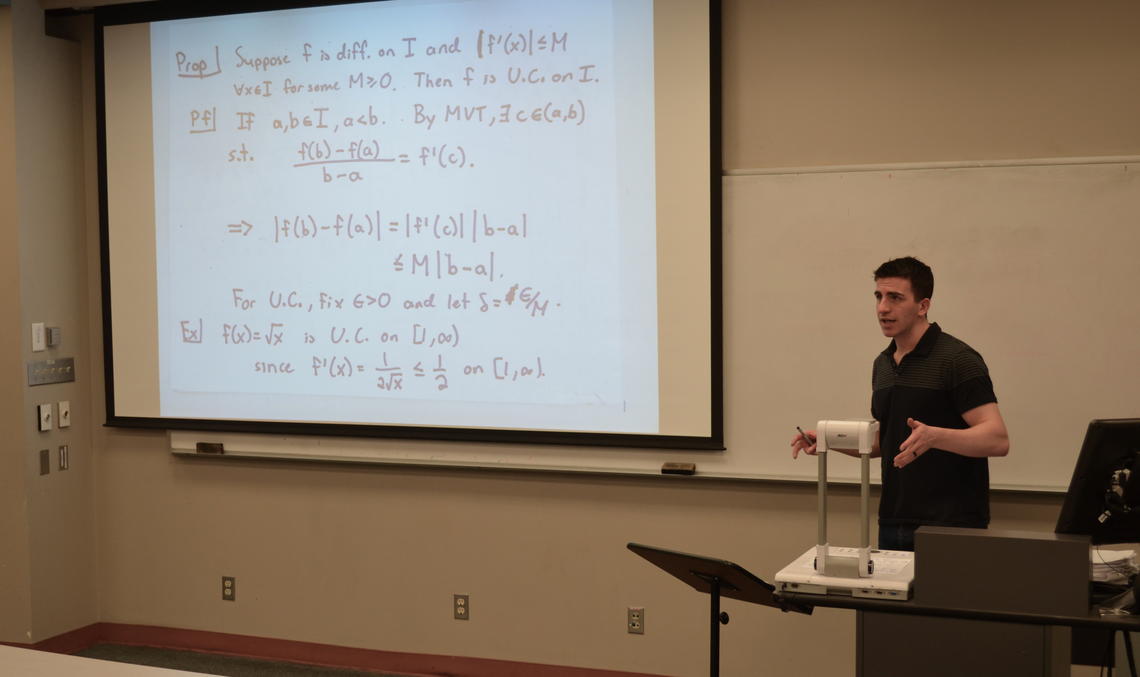Dec. 12, 2014
Mathematics course gives undergrads peer-teaching experience

Ryan Hamilton, sessional instructor, Department of Mathematics and Statistics.
Susan Cannon, University of Calgary
Undergraduate students in MATH 335 experienced active learning in the form of peer teaching this past semester. In the tutorial, sessional instructor Ryan Hamilton randomly chooses students who have previously volunteered to present their solutions to homework assignments while explaining the process to their peers.
With this method, students get the opportunity to articulate their thinking and explain their unique approaches to solving mathematical proofs, all in the encouraging environment of their peers who, along with Hamilton, ask questions and offer support.
We asked Hamilton to talk about this method of blending problem-solving and active learning.
Q: First, tell us about the course MATH 335: Analysis I. How does it relate to calculus?
A: This course covers the abstract and theoretical underpinnings of all modern calculus. Whether it’s differential equations, which model physical systems or probability distributions governing basic physics and chemistry, analysis is present anywhere there are rates of change.
Q: How do students find the subject matter?
A: To adopt this analytical mindset is challenging and even mathematics majors can find the transition to this more abstract way of thinking difficult. The payoff for students is a clear and consistent understanding of theory. But in my view, the theoretical underpinnings are also worth exploring in the same way we might view a piece of art.
Q: What was the inspiration behind having undergrads solve these kinds of problems in front of their peers?
A: When I was a graduate student at the University of Waterloo, I was part of a large and highly active research group. We participated in weekly learning seminars where we took turns explaining solutions to difficult problems in the literature. Having to speak for 90 minutes every six weeks or so was incredibly important in developing what I consider to be the paramount feature in communicating mathematics: clarity.
I wanted to give the students in this class the opportunity to practice this skill in a supportive environment. And I didn’t want to have them wait until graduate school to get that kind of learning experience and feedback.
Q: How has this peer teaching activity worked out?
A: The students work on their solutions prior to the tutorial. Whoever’s selected then uses the document viewer to work out a full solution while explaining their process to classmates. I stay quiet unless the student starts to take a wrong turn or needs a prompt to keep speaking. Sometimes a student has a unique and creative solution to a formula and I make a point of highlighting that to the class.
The greatest benefit of this exercise is how encouraging the students are with each other, and how students thrive in this supportive learning environment. Given that the group is about 60 students, there is obvious anxiety in most of the students selected. The support of their peers tends to mitigate these feelings.
Q: Do you think this peer teaching method is effective in undergraduate Mathematic courses?
A: It can be incredibly easy in mathematics as an instructor to disconnect with your students when you’re working through the problems yourself in front of the class. Peer teaching is a great way to get the students engaged. And there is ample research literature on learning that shows students learn most effectively when they’re encouraged to explain difficult and multi-step problems to each other.
I view the course material through the lens of a subject expert, which I think is a hindrance at times. Students can help each other learn because most of them are at the same place in their understanding of the material. They can articulate where they get stuck and what they found hard as novice mathematicians in a way I sometimes can’t see. It’s my goal to provide an environment in class or a tutorial where students are willing to do activities like peer teaching.
